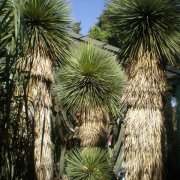Care of the shrub Yucca thompsoniana or Thompson's yucca |
|
The genus Yucca, family Asparagaceae, comprises 50 species of evergreen shrubs native to Mexico, the United States, and the Caribbean. Some species are: Yucca thompsoniana, Yucca baccata, Yucca schidigera, Yucca rostrata, Yucca mixtecana, Yucca gloriosa, Yucca filifera, Yucca elephantipes, Yucca desmetiana, Yucca carnerosana, Yucca aloifolia, Yucca whipplei. Common names: Thompson's yucca, Beaked yucca. This species is native to Texas (USA), Chihuahua and Coahuila (Mexico). They are branched bushy or arborescent plants that reach 4 meters (13.12 feet) in height. The leaves are elongated and appear in spherical groups at the end of the branches; They are bluish-green in color with finely serrated margins. They produce large floral panicles (up to 1 meter/3.28 feet high) with white bell-shaped flowers. They bloom in summer. Thompson's yucca is used in rockery, in dry, poor and sunny areas of the garden and as isolated specimens. Yucca thompsoniana needs full sun exposure and high temperatures. It resists frost down to -15 ºC (5 ºF). Beaked yucca can grow in any well-drained soil be it rocky, sandy, or stony. Thompson's yucca is very resistant to drought; it only needs occasional watering in summer. The rest of the year it's maintained with the rains (in Mediterranean climates). Yucca thompsoniana does not need fertilizers. Prune the withered inflorescences and the basal branches if you want to obtain an arboreal bearing. Thompson's yucca is a plant resistant to pests and diseases but sensitive to excess humidity. Yucca thompsoniana propagates from seeds sown in spring in a slightly humid sandy substrate. |
Images of the shrub Yucca thompsoniana or Thompson's yucca |
Find plants
Yucca thompsoniana or Thompson's yucca | Care and Growing
© 2025 FavThemes

